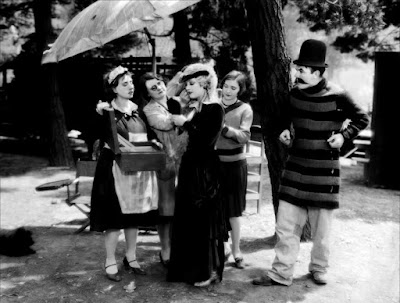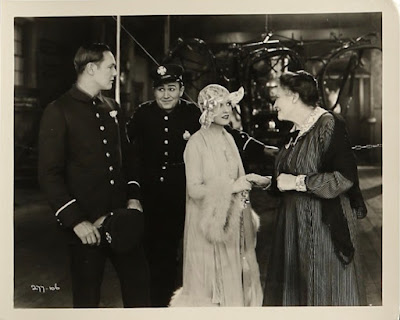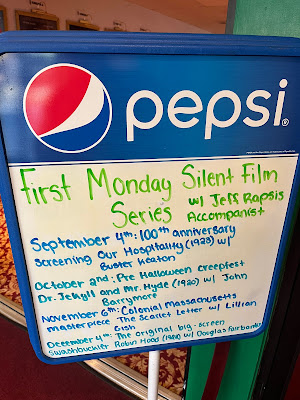Happy Silent Movie Day!
I'm celebrating this not-quite-Hallmark holiday (yet) by accompanying a screening of 'The Hunchback of Notre Dame' (19230 starring Lon Chaney.
Showtime is tonight (Friday, Sept. 29) at 7 p.m. at the Derry Opera House. Details in the press release below.
And talk about celebrating—this evening's screening comes in the middle of a run of six screenings in six days!
Last Wednesday, it was Buster Keaton's 'Seven Chances' (1925) at the Rex Theatre in Manchester, N.H.; then yesterday is was Keaton's 'Our Hospitality' (1923) for a retirement community in Concord, N.H.
Tomorrow, I'll be down in Cambridge, Mass. to accompany a screening of Keaton's 'Three Ages' (1923) at the Brattle Cinema; then it's another 'Hunchback' on Sunday, Oct. 1 in Natick, Mass., and then on Monday, Oct. 2 it's the John Barrymore 'Dr. Jekyll & Mr. Hyde' (1920) at the Garden Cinemas out in Greenfield, Mass.
So as we observe Silent Movie Day 2023, I hope you'll join me for a silent film screening or two (or six) near you!
Here's the press release for tonight's 'Hunchback' screening:
* * *
Lon Chaney in the title role of 'The Hunchback of Notre Dame' (1923).THURSDAY, SEPT. 21, 2023 / FOR IMMEDIATE RELEASE
Contact Jeff Rapsis • (603) 236-9237 • jeffrapsis@gmail.com
Chaney as Quasimodo in 'Hunchback of Notre Dame' on Friday, Sept. 29 in Derry, N.H.
Celebrate 100th anniversary of classic silent version with screening at Derry Opera House; featuring live music by Jeff Rapsis
DERRY, N.H.—It was a spectacular combination: Lon Chaney, the actor known as the "Man of 1,000 Faces," and Universal's big screen adaptation of Victor Hugo's sprawling tale of the tortured Quasimodo.
The result was the classic silent film version of 'The Hunchback of Notre Dame' (1923), to be shown with live music on Friday, Sept. 29 at 7 p.m. at the Derry Opera House, 29 West Broadway, Derry, N.H.
The special 100th anniversary screening will be accompanied with live music by silent film musician Jeff Rapsis.
The screening is organized by the Derry Public Library. Admission is free and the program is open to all.
"We felt that with the upcoming reopening of Notre Dame
Cathedral in 2024, audiences would appreciate a chance to see this
film, which takes place throughout the iconic structure," Rapsis said.
The famous cathedral, a symbol of Paris and France, was severely damaged by fire in 2019.
The
film is based on Victor Hugo's 1831 novel, and is notable for the grand
sets that recall 15th century Paris as well as for Chaney's performance
and make-up as the tortured hunchback Quasimodo.
The
film elevated Chaney, already a well-known character actor, to full
star status in Hollywood, and also helped set a standard for many later
horror films, including Chaney's 'The Phantom of the Opera' in 1925.
While Quasimodo is but one of many interconnecting characters in the original Hugo novel, he dominates the narrative of this expensive Universal production.
In the story, Jehan (Brandon Hurst), the evil brother of the archdeacon, lusts after a Gypsy named Esmeralda (Patsy Ruth Miller) and commands the hunchback Quasimodo (Chaney) to capture her.
Military captain Phoebus (Norman Kerry) also loves Esmeralda and rescues her, but the Gypsy is not unsympathetic to Quasimodo's condition, and an unlikely bond forms between them.
After vengeful Jehan frames Esmeralda for the attempted murder of Phoebus, Quasimodo's feelings are put to the test in a spectacular climax set in and around the Cathedral of Notre Dame.
As the hunchbacked bellringer Quasimodo, Chaney adorned himself with a special device that made his cheeks jut out grotesquely; a contact lens that blanked out one of his eyes; and, most painfully, a huge rubber hump covered with coarse animal fur and weighing anywhere from 30 to 50 pounds.
Chaney deeply identified with Quasimodo, the deformed bell-ringer at Notre Dame Cathedral who was deafened by his work. Chaney was raised by deaf parents and did a lot of his communication through pantomime.
“The idea of doing the picture was an old one of mine and I had studied Quasimodo until I knew him like a brother, knew every ghoulish impulse of his heart and all the inarticulate miseries of his soul,” Chaney told an interviewer with Movie Weekly magazine in 1923.
“Quasimodo and I lived together—we became one. At least so it has since seemed to me. When I played him, I forgot my own identity completely and for the time being lived and suffered with the Hunchback of Notre Dame.”A scene from 'The Hunchback of Notre Dame' (1923).
The film was a major box office hit for Universal Studios, and Chaney's performance continues to win accolades even today.
"An awe-inspiring achievement, featuring magnificent sets (built on the Universal backlot), the proverbial cast of thousands (the crowd scenes are mesmerizing) and an opportunity to catch Lon Chaney at his most commanding," wrote critic Matt Brunson of Creative Loafing in 2014.
Screening this classic version of 'Hunchback' provides local audiences the opportunity to experience silent film as it was intended to be shown: on the big screen, in restored prints, with live music, and with an audience.
"If you can put pieces of the experience back together again, it's surprising how these films snap back to life," said Rapsis, a New Hampshire-based silent film accompanist who creates music for silent film screenings at venues around the country.
"By showing the films as they were intended, you can really get a sense of why people first fell in love with the movies."
In creating music for silent films, Rapsis performs on a digital synthesizer that reproduces the texture of the full orchestra and creates a traditional "movie score" sound.
'The Hunchback of Notre Dame' (1923) starring Lon Chaney, will be screened with live music on Friday, Sept. 29 at 7 p.m. at the Derry Opera House, 29 West Broadway, Derry, N.H.
Admission is free. For more info, visit www.derrypl.org or call (603) 432-6140.











































